A recent episode of NOVA, “The Violence Paradox,” highlighted evidence of decreasing violence over the last seven centuries and yet, many communities in the United States, particularly some cities, are experiencing more violence. What caught my attention was that the decrease in violence was partially tied to the rise of literacy, the rise of the ability for the common person to read and understand others. The ensuing increase in empathy over time saw the emergence of the idea of equity.
Making the World More Peaceful
“Despite the constant news of violence, from mass shootings to wars, psychologist Steven Pinker believes we may be living in one of the most peaceful periods in human existence. Could it be true that physical violence has been in decline for centuries? And can it be prevented—or is it simply part of human nature? NOVA takes you on a journey through history and the human mind to explore what triggers violence and how it may have decreased over time. Taking clues from a Kenyan archaeology site, modern laboratory experiments, and even literature, researchers trace the social and neurobiological roots of human violence. They look at how forces like income equality and personal contact may curb violence in modern societies. And in places like Baltimore, where violence “interrupters” treat violence like a contagious disease, NOVA examines evidence-based approaches to making the world more peaceful. (Premiered November 20, 2019)”
“The Violence Paradox,”
Arts Help Students At-Risk
One of the findings in my research on the role of the arts in education, specifically arts integration, where the arts are used to help boost student achievement, is that we have found a remarkable outcome—that students who are at-risk for achievement, socio-economic background, or language—are more likely to increase their achievement when the arts are present. Now this isn’t just the presence of art classes or parent provided music lessons. This is where a teaching artist coordinates with the classroom teacher to use the arts as integrated with school curriculums to engage and support student learning. After four large studies the evidence that the arts integration can help students who are at risk for a variety of factors can actually achieve at higher levels has been established by research in the field. (Southworth, et. al., 2007, 2014, 2017).
Equity
Which brings up the idea of why violence is decreasing. In NOVA’s piece, the decrease in violence overall is well documented, but the increase in city violence in Baltimore is hard to explain. Why does Baltimore, Detroit, and St. Louis suffer from increasing violence? And most importantly from my educational point of view, why do students from those cities perform less well? NOVA tells us that equity as an idea arises from the middle ages with the rise of the printed word. When the common person began to understand the Bible from their own reading, instead of understanding it through the spoken word and interpretation by the priest, a subtle shift occurred. People could read about other people and better understand their intentions and their actions. We all became more equal in the format of writing about our story and reading about other’s stories. Bur students in Baltimore don’t share that equity.
Access
Writing can facilitate people becoming more equal, but it does to some extent depend on access to the literature. And not just from a practical, access to books point-of-view, but also from the more important aspect of access to important ideas point-of-view. When the framers of the constitution wrote, “that all men are created equal,” the phrase can be repeated orally to anyone in our country to give them hope, but the access to the idea, including the understanding that “men” was exclusionary to women, slaves, and prisoners was closed off. What would it mean to write a constitution where every person was created equal and the law treated them fairly? What if all curriculum was created so that every learner can learn from it equally?
Arts Can Provide Access
Remember, the arts don’t do anything. The Constitution doesn’t do anything. They are both tools that our citizens decide to use hopefully for the good of the country. In the art’s case, introducing the arts into fourth grade classroom, for example, by singing a song about the Erie Canal, helps students enjoy and remember what the Erie Canal was all about. If you ask those same students to draw a diagram of how the locks work, they never forget. Essentially, the singing of the songs and the drawing of the locks gives them access to important curriculum ideas. When you teach through the arts you give access to those ideas, which creates equity in learning. Before this, only the students who can more easily visualize the curriculum or more easily memorize are given full access, as struggling students who are at risk struggle to make meaning of a curriculum they cannot visualize or remember. The real difference is the quality of the teacher, not the quality of the learner. If a high-quality teacher provides multiple ways for students to gain access to the curriculum, amazing things in learning will result. The arts are a very good tool in this process of creating equity.




